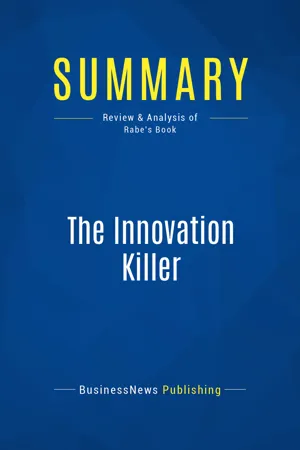
Summary: The Innovation Killer
Review and Analysis of Rabe's Book
- English
- ePUB (mobile friendly)
- Available on iOS & Android
About This Book
The must-read summary of Cynthia Rabe's book: `The Innovation Killer: How What We Know Limits What We Can Imagine - And What Smart Companies Are Doing About It”.
This complete summary of the ideas from Cynthia Rabe's book `The Innovation Killer` shows that thinking innovatively is a challenge for many organisations because it requires a rather delicate balancing act. On the one hand, creative ideas need to draw on some specific and well established expertise but at the same time, the conventional thinking needs to be challenged. In her book, the author explains the importance of bringing in temporary team members who can look at the situation from a fresh perspective and think outside the box. This summary is a must-read for every manager who wants to encourage innovation and creativity in their business.
Added-value of this summary:
• Save time
• Understand key concepts
• Expand your knowledge
To learn more, read `The Innovation Killer` and find out how you can make changes to allow for more innovation in your company.
Frequently asked questions
Information
Summary of The Innovation Killer (Cynthia Rabe)
1. Why Innovation is Difficult For Most Organizations

- In some organizations, new ideas need to pass through numerous filters of various kinds before they get picked up on. These filters may consist of requiring management approval, needing resources to be made available or even something as simple as expecting new ideas to come from the top down rather than the bottom up. It isn’t at all unusual for those filters to block off any encouraging new ideas which don’t have the right backing or pedigree.
- Human nature often resists new and original thinking. People naturally assume if an idea is good, everyone would already be doing that. So inline with that sentiment, often people don’t even bother to dream up new ideas.
- Company policy may require new ideas to be backed up with facts and figures which nobody has any chance of generating. Or all kinds of other stringent management policies may provide other disincentives.
- There is a tendency for organizations to have momentum – they want to keep doing what they have always done. Disruptive innovations which get in the way of the company’s operations are therefore frowned upon and discouraged.
- All kinds of internal politics and turf wars can get in the way. People may be reluctant to integrate a new innovation because it will upset the current division of power and resources within the company.
- GroupThink – the tendency of a group of people to agree with the people they work alongside rather than speaking their mind. GroupThink is evidenced by the fact a group of people working together try and craft unanimous decisions, even if those decisions aren’t necessarily the best ones available. In simple terms, GroupThink exerts pressure on those with minority opinions to go along with what the majority wants to do. GroupThink seeks to create the illusion of agreement even when some members of the group have individual opinions which are decidedly different. Some of the most famous examples of wooly GroupThink throughout history have included:
- The failure of Enron’s board to act decisively.
- The U.S. disaster at the Bay of Pigs in 1961.
- The explosion of Nasa’s shuttle Challenger in 1986.
- The case for the U.S. invasion of Iraq in 2004.
In the business context, GroupThink stops people from stating their opinions openly and vocally. Instead, people become a little shy and go along with what the majority opinion is. This is a basic human nature tendency which is very tough to overcome. GroupThink can strike the most junior person in the organization or the most seasoned leader alike. - ExpertThink – sometimes described as “GroupThink on steroids”. If GroupThink is going along to get ahead, ExpertThink is going along with what those with expertise in that field say. ExpertThink occurs when everyone in an organization makes decisions and analyzes situations using the same mindset. In essence, it means to accept unilaterally what worke...
Table of contents
- Title page
- Book Presentation
- Summary of The Innovation Killer (Cynthia Rabe)
- About the Summary Publisher
- Copyright